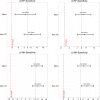Multicenter Noninferiority Evaluation of Hain GenoType MTBDRplus Version 2 and Nipro NTM+MDRTB Line Probe Assays for Detection of Rifampin and Isoniazid Resistance
- PMID: 27076658
- PMCID: PMC4879293
- DOI: 10.1128/JCM.00251-16
Multicenter Noninferiority Evaluation of Hain GenoType MTBDRplus Version 2 and Nipro NTM+MDRTB Line Probe Assays for Detection of Rifampin and Isoniazid Resistance
Abstract
Less than 30% of multidrug-resistant tuberculosis (MDR-TB) patients are currently diagnosed, due to laboratory constraints. Molecular diagnostics enable rapid and simplified diagnosis. Newer-version line probe assays have not been evaluated against the WHO-endorsed Hain GenoType MTBDRplus (referred to as Hain version 1 [V1]) for the rapid detection of rifampin (RIF) and isoniazid (INH) resistance. A two-phase noninferiority study was conducted in two supranational reference laboratories to allow head-to-head comparisons of two new tests, Hain Genotype MTBDRplus version 2 (referred to as Hain version 2 [V2]) and Nipro NTM+MDRTB detection kit 2 (referred to as Nipro), to Hain V1. In phase 1, the results for 379 test strains were compared to a composite reference standard that used phenotypic drug susceptibility testing (DST) and targeted sequencing. In phase 2, the results for 644 sputum samples were compared to a phenotypic DST reference standard alone. Using a challenging set of strains in phase 1, the values for sensitivity and specificity for Hain V1, Hain V2, and Nipro, respectively, were 90.3%/98.5%, 90.3%/98.5%, and 92.0%/98.5% for RIF resistance detection and 89.1%/99.4%, 89.1%/99.4%, and 89.6%/100.0% for INH resistance detection. Testing of sputa in phase 2 yielded values for sensitivity and specificity of 97.1%/97.1%, 98.2%/97.8%, and 96.5%/97.5% for RIF and 94.4%/96.4%, 95.4%/98.8%, and 94.9%/97.6% for INH. Overall, the rates of indeterminate results were low, but there was a higher rate of indeterminate results with Nipro than with Hain V1 and V2 in samples with low smear grades. Noninferiority of Hain V2 and Nipro to Hain V1 was demonstrated for RIF and INH resistance detection in isolates and sputum specimens. These results serve as evidence for WHO policy recommendations on the use of line probe assays, including the Hain V2 and Nipro assays, for MDR-TB detection.
Copyright © 2016 Nathavitharana et al.
Figures


References
-
- Heifets LB, Cangelosi GA. 1999. Drug susceptibility testing of Mycobacterium tuberculosis: a neglected problem at the turn of the century. Int J Tuberc Lung Dis 3:564–581. - PubMed
Publication types
MeSH terms
Substances
Grants and funding
LinkOut - more resources
Full Text Sources
Other Literature Sources
Medical

